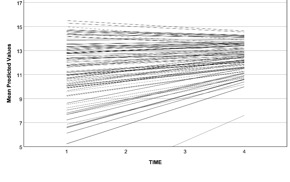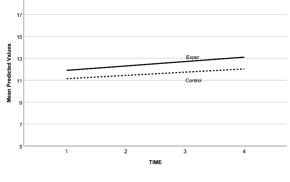The Instant Effect of Aerobic Exercise on Pre-Math Skills of 4-6 Year-Old Children
|
Teaching (Today for) Tomorrow: Bridging the Gap between the Classroom and Reality 3rd International Scientific and Art Conference |
|
Ivan Šerbetar1, Laura Horvat2, Maja Ivić31Faculty of Teacher Education, University of Zagreb, 2Kindergarten Zvončić Nedelišće, 3Kindergarten Vrbovec ivan.serbetar@ufzg.unizg.hr |
|
| Section - Kinesiology education and sports | Paper number: 60 |
Category: Original scientific paper |
Abstract |
|
The current study assessed the acute effects of aerobic exercise on early numeracy of preschool children. Ninety-three children were randomly assigned to either experimental or control groups. Except for 5 minutes of warm-up and 5 minutes of cooling down activities, the exercise protocol performed by the experimental group involved games and relay races at moderate to vigorous (MVPA) intensity for 20 minutes. Immediately following the exercise, participants from the experimental group completed math tasks in numeracy, operations, geometry and spatial sense, patterning, and measurement. The control group completed the same tasks, but the test time was unrelated to the exercise. The experimental procedure was conducted once a week for one month, allowing four assessments. Composite scores of each math test were used as outcomes in LMM analysis, with results favoring children from the experimental group and yielding significant effects of time. The study suggests that acute exercise may benefit some aspects of early numeracy skills in preschool children. |
|
Key words: |
|
early numeracy; exercise; preschool children |
Introduction
Exercise and executive functions
A large amount of research has established that exercise could enhance mental health and that it also has a potential influence on decreasing cognitive decay in aging and psychiatric disorders (Gomez-Pinilla & Hillman, 2013). Additionally, there is growing interest in studies that explore the relationship between exercise and academic skills and/or executive functions (EFs), defined by Miyake and Friedman (2012) as a set of general-purpose control mechanisms linked to the prefrontal cortex, which regulates the dynamics of human cognition and action. In general, EFs can be viewed as elementary control processes like regulation of behavior, planning, self-monitoring, self-control, problem-solving, and maintenance of attention (Miyake & Friedman, 2012), or in a more reductionist view, as three elements (updating, shifting, inhibition).
Academic skills and EFs are closely related; moreover, EFs are significant predictors of later academic performance (Cameron et al., 2012). Early numeracy is an essential part of academic skills, encompassing skills related to numerical relationships and counting, which form a crucial base for future success in mathematics and overall academic achievement (Aunio & Niemivirta, 2010). EFs can differently impact early numeracy; for example, updating may be essential for storing and accessing partial results during the execution of the tasks, inhibition may restrain unsuitable approaches to mathematical problems, and switching facilitates the transition between different tasks (Bull & Lee, 2014).
Intervention using fundamental motor skills (FMS) has already been demonstrated to significantly benefit cognitive development and academic skills in young children (3-7 yrs), as shown by Jylanki et al. (2022); significant relations between FMS and inhibition (Cook et al., 2019) and updating, respectively, were also found (Gashaj et al., 2019). In another study on 4-yr-olds, Willougby et al. (2021) found that even though motor skills were highly related to existing measures of EFs and math skills (rs = .51-.63), MVPA was only slightly associated with EFs and math problem-solving skills (rs = .03-.18).
Linear mixed effects modeling
The main concern in the randomized experiment analyzing the influence of intervention on an outcome are the changes in outcome over time. Therefore, making an appropriate model and assessing the change have to be considered. Traditionally, repeated measures ANOVA (RMA) has been used in that type of research design to assess the differences between the mean of the groups, treating departures from the mean as error variance and disregarding the actual quantity of change in individuals (Duncan & Duncan, 2004). From a statistical analysis viewpoint, such models raise certain doubts primarily because of the inadequate handling of missing and unbalanced data and time-varying predictors (Kwok et al., 2008).
A more advanced approach, known as linear mixed effects modeling (LMM), identifies changes as a continuous process that changes in time, which could be confined by an individual trajectory (Hedeker & Gibbons, 2006). LMMs are enhanced versions of linear regression models that include random effects and address correlated errors; they are often referred to as multilevel models, which are closely associated with hierarchical or growth models. An LMM starts in the form of linear regression, but similarly to the ANOVA, it may include fixed effects (group effects) that are constant across individuals. The initial form of LMM commonly incorporates a subject as a random effect (referred to as a random intercept). Therefore, as described, LMM represents a mix of fixed and random effects. LMM allows the inclusion of further random effects by integrating random slope or repeated structures, allowing higher flexibility in the correlation structure of repeated measures.
Conversely to the RMA, LMMs incorporate individuals with missing data points into the study, as the observed values are utilized to ascertain the longitudinal trajectory via random effects (Walker et al., 2019). One more benefit of LMMs is their capability to model both linear variations over time in the outcome and nonlinear changes across multiple trials; furthermore, in RMA, time needs to be considered as a categorical variable, whereas LMM can handle time as either a continuous or categorical variable (Walker et al., 2019).
Since prior studies examining acute bouts of exercise on young children's academic skills are rare, the current research aims to initially explore the immediate impact of exercise on pre-math skills in preschool children.
Methods
A convenient sample of 93 children (41 girls) aged 4-6 from local kindergartens was used. The children were randomly divided into control and experimental groups. For all the children, the signed consent from the parents was obtained. The experimental group was involved in moderate to vigorous physical activity, mainly consisting of fast-paced games and relay races comprising tagging, chasing, running, and jumping, which lasted up to twenty minutes and was preceded and followed by 5 minutes of warm-up and cooling-down activities. Intensity was monitored using indicators such as sweating, rapid breathing, and heart rate (HR). To be objective as much as possible, children were individually briefly interrupted in activity, allowing HR to be assessed using a medical pulse oximeter. The new generation of such devices could grant reliable measures of HR in real-life activities (Marinari et al., 2022). Although, as noted by Douglas et al. (2020), identifying the MVPA HR threshold is difficult due to the variability and age-related differences in resting and peak HR, the suggested methodology from the paper above was accepted, and the range of 124-160 was considered moderate intensity while 160 - 190 was regarded vigorous. The upper limit of the actual range observed during sessions never exceeded 170.
Math tasks covered domains of numeracy, operations, geometry and spatial sense, patterning, and measurement. The assessment was performed immediately after exercise in the experimental group. In contrast, the time for the evaluation of the control group was chosen randomly among other children's daily activities independently of the exercise. Four trained preschool teachers performed the assessment, each monitoring up to four children simultaneously and providing them with standardized instructions. The math tasks were presented in the form of printed worksheets designed in cooperation with the early math teaching expert. Writing or reading skills were not necessary for task solving, but only an indication of the correct answer using an arrow or a circling.
Results
LMM was applied to assess repeated measurements of math tasks. The first model was built with gender and group as a fixed effect and time as covariate. In that model, random effects were allowed only for intercepts that captured the subject's individuality, but subjects shared a common slope. The covariance type was set to variance component, which allowed correlations between intercept and slope but did not affect the analysis since only the intercept was set as random. The -2 Log Likelihood information criteria was used and yielded a value of 1741.57.
The second model was fitted by including the random slopes for time, assuming that this is more realistic and more appropriate for the current data. The covariance structure was set to unstructured. Gender was omitted from the second model since it did not contribute significantly to the prediction in the first model. The -2 Log Likelihood for the second model was 1722.31. Since the difference between information criteria from the first and second model, with a df change of 2, was greater than the critical value for the chi-square distribution for the alpha at .05, the second model with random intercept and random slope was retained and interpreted (Figure 1).
Figure 1. Random intercept and random slope model

The fixed effects test indicated a significant influence of the group (F(1, 77.297) = 4.10, p=.046) and time (F(1, 76.693) = 6.65, p=.012) on the outcome. The fixed effects parameter estimates (Table 1) implied that the children in the experimental group scored on the outcome significantly higher than the children in the control group (B = .99 SE = .49, p = 0.046), while the math scores increased by .35 for each additional time point (B = .35, SE = .13, p = 0.012), which is also shown in Figure 2. The mean values for the treatment and control groups were M=12.54 (SE=.368) and M=11.55 (SE=.352), respectively.
Figure 2. Math scores by group and time

Table 1. LMM model estimates with a group as the fixed effect, time as the covariate, and math score as an outcome
|
Parameter |
Estimate |
SE |
df |
Sig. |
95% Confidence Interval |
|
|
|
Lower Bound |
Upper Bound |
||||
|
Intercept |
10.69 |
.58 |
122.89 |
0.000 |
9.60 |
11.78 |
|
Group |
0.99 |
.49 |
77.30 |
0.046 |
0.02 |
1.97 |
|
Time |
0.35 |
.13 |
76.69 |
0.012 |
0.08 |
0.61 |
The estimates of variance parameters for random effects indicated variance of random intercept of Var=12.17 (p<.001), which suggests that math scores varied significantly across the subjects at baseline. The variance of the subjects' slopes also varied significantly but was low Var=1.88 (p<.05), suggesting that math scores varied also over time.
The intraclass correlation coefficient was estimated (ICC = .665), implying that a considerable fragment of the variability (∼67%) in the outcome is associated with the differences between subjects. This suggests that there are possibly other factors that contributed to performance. The significant effect of time may indicate that familiarization with testing procedures occurred, resulting in learning in both groups.
Discussion
The current study assessed the influence of acute aerobic exercise on early math skills through repeated measurements. According to the results, it seems that exercise-induced benefits manifested in better performance in math tasks in the treatment group.
The study by Martins et al. (2021) assessed the effect of acute continuous (CON) and intermittent (INT) physical activity (PA) on 10-year-old children's executive function (EF). The research showed that the INT condition improved at 30 min post, showing a delayed benefit from the PA bout and greater improvements than the continuous condition. The study by Lambrick et al. (2016) examined the effects of acute exercise on executive function in prepubescent children (mean age: 8.8 years) to explore its potential for enhancing school performance. Children completed 15-minute continuous and intermittent treadmill exercises with varying intensity levels. Both exercise types improved Stroop task performance, with improvements evident 1-minute post-exercise and lasting up to 30 minutes. However, the improvement in executive function was more strongly linked to cerebral oxygenation changes during INT exercise as measured by NIRS device. Although there is a substantial similarity between the study mentioned above and the current study, there is also a difference in the age of the subjects but also in applied intensity.
As acknowledged by the Centers for Disease Control and Prevention (2010), previous research has shown that physical activity can affect the physiology of the brain by increasing cerebral capillary growth, blood flow, oxygenation, production of neurotrophins, growth of nerve cells in the hippocampus, neurotransmitter levels, development of nerve connections, density of the neural network, and brain tissue volume.
Which of the quoted biological processes or mechanisms is responsible for improving math skills observed in the current study could only be speculated. Still, regarding findings from other studies (i.e., Lambrick et al., 2016), elevated frontal lobe cerebral perfusion would be the top candidate. Nevertheless, according to the CDC (2010), engagement in acute exercise may have residual effects on cognition, suggesting that physical activity before complex learning tasks may be beneficial.
Conclusions
The present study provides evidence that acute aerobic exercise positively influences early numeracy skills in preschool children. The results demonstrated that children in the experimental group, who engaged in moderate to vigorous physical activity before assessment, performed significantly better on math tasks compared to those in the control group. The findings align with prior research suggesting that physical activity can enhance cognitive functions, potentially through mechanisms such as increased cerebral perfusion and neurobiological adaptations. While the exact physiological processes behind these improvements remain speculative, the study underscores the potential of integrating structured physical activity into early childhood education to support cognitive and academic development. Future research should explore long-term effects of exercise on numeracy skills and investigate the optimal intensity and duration of physical activity for maximizing cognitive benefits in young children.
References
|
Aunio, P., & Niemivirta, M. (2010). Predicting children's mathematical performance in grade one by early numeracy. Learning and Individual Differences, 20(5), 427–435. https://doi.org/10.1016/j.lindif.2010.06.003 |
|
Bull, R., & Lee, K. (2014). Executive functioning and mathematics achievement. Child Development Perspectives, 8 (1), 36–41. https://doi.org/10.1111/cdep.12059. |
|
Cameron, C. E., Brock, L. L., Murrah, W. M., Bell, L. H., Worzalla, S. L., Grissmer, D., & Morrison, F. J. (2012). Fine motor skills and executive function both contribute to kindergarten achievement. Child Development, 83(4), 1229–1244. https://doi.org/10.1111/j.1467-8624.2012.01768.x |
|
Cook, C. J., Howard, S. J., Scerif, G., Twine, R., Kahn, K., Norris, S. A., & Draper, C. E. (2019). Associations of physical activity and gross motor skills with executive function in preschool children from low-income South African settings. Developmental Science, 22(5), e12820. https://doi.org/10.1111/desc.12820 |
|
Centers for Disease Control and Prevention [CDC]. (2010). The association between school based physical activity, including physical education, and academic performance. Atlanta, GA: U.S. Department of Health and Human Services. Web. 10 Jan. 2025. |
|
Douglas, H., Raywood, E., Kapoor, Murray, K.N., O'Connor, R., Liakhovich, O. et al. (2020). Identifying heart rate threshold for moderate to vigorous physical activity in children and young people wearing activity trackers. European Respiratory Journal, 56.suppl 64: 267. Web. 10 Jan. 2025. |
|
Duncan, T.E., & Duncan, S.C. (2004). An introduction to latent growth curve modeling. Behav. Ther. 35 (2), 333-363. |
|
Gashaj, V., Oberer, N., Mast, F. W., & Roebers, C. M. (2019). Individual differences in basic numerical skills: The role of executive functions and motor skills. Journal of Experimental Child Psychology, 182, 187–195. https://doi.org/10.1016/j.jecp.2019.01.021 |
|
Gomez-Pinilla, F., & Hillman, C. (2013). The influence of exercise on cognitive abilities. Comprehensive Physiology, 3(1), 403–428. https://doi.org/10.1002/cphy.c110063 |
|
Hedeker, D., Gibbons, R.D. (2006). Longitudinal Data Analysis. Wiley |
|
Jylänki, P., Mbay, T., Hakkarainen, A., Sääkslahti, A., & Aunio, P. (2022). The effects of motor skill and physical activity interventions on preschoolers' cognitive and academic skills: A systematic review. Preventive Medicine, 155, 106948. https://doi.org/10.1016/j.ypmed.2021.106948 |
|
Kwok, O. M., Underhill, A. T., Berry, J. W., Luo, W., Elliott, T. R., & Yoon, M. (2008). Analyzing Longitudinal Data with Multilevel Models: An Example with Individuals Living with Lower Extremity Intra-articular Fractures. Rehabilitation Psychology, 53(3), 370–386. https://doi.org/10.1037/a0012765 |
|
Lambrick, D., Stoner, L., Grigg, R., & Faulkner, J. (2016). Effects of continuous and intermittent exercise on executive function in children aged 8-10 years. Psychophysiology, 53(9), 1335–1342. https://doi.org/10.1111/psyp.12688 |
|
Marinari, S., Volpe, P., Simoni, M., Aventaggiato, M., De Benedetto, F., Nardini, S., Sanguinetti, C. M., & Palange, P. (2022). Accuracy of a New Pulse Oximetry in Detection of Arterial Oxygen Saturation and Heart Rate Measurements: The SOMBRERO Study. Sensors, 22(13), 5031. https://doi.org/10.3390/s22135031 |
|
Martins, R. M. G., Duncan, M. J., Clark, C. C. T., & Eyre, E. L. J. (2021). The acute effects of continuous and intermittent cycling on executive function in children. Acta Psychologica, 218, 103363. https://doi.org/10.1016/j.actpsy.2021.103363 |
|
Miyake, A., & Friedman, N. P. (2012). The Nature and Organization of Individual Differences in Executive Functions: Four General Conclusions. Current Directions in Psychological Science, 21(1), 8–14. https://doi.org/10.1177/0963721411429458 |
|
Snijders, T. A. B., & Bosker, R. J. (2012). Multilevel analysis: an introduction to basic and advanced multilevel modeling. SAGE. |
|
Walker, E. A., Redfern, A., & Oleson, J. J. (2019). Linear Mixed-Model Analysis to Examine Longitudinal Trajectories in Vocabulary Depth and Breadth in Children Who Are Hard of Hearing. Journal of Speech, Language, and Hearing Research: JSLHR, 62(3), 525–542. https://doi.org/10.1044/2018_JSLHR-L-ASTM-18-0250 |
|
Willoughby, M., Hudson, K., Hong, Y., & Wylie, A. (2021). Improvements in motor competence skills are associated with improvements in executive function and math problem-solving skills in early childhood. Developmental Psychology, 57(9), 1463–1470. https://doi.org/10.1037/dev0001223 |
Odgoj danas za sutra: Premošćivanje jaza između učionice i realnosti 3. međunarodna znanstvena i umjetnička konferencija Učiteljskoga fakulteta Sveučilišta u Zagrebu Suvremene teme u odgoju i obrazovanju – STOO4 u suradnji s Hrvatskom akademijom znanosti i umjetnosti |
Neposredan utjecaj aerobnog vježbanja na
predmatematičke vještine djece od 4-6 godina
|
Sažetak |
|
U istraživanju su ispitani neposredni učinci aerobnog vježbanja na rane matematičke vještine djece predškolske dobi. Devedeset i troje djece nasumično je raspoređeno u eksperimentalnu ili u kontrolnu skupinu. Osim 5 minuta aktivnosti zagrijavanja i 5 minuta opuštanja, protokol vježbanja eksperimentalne skupine uključivao je elementarne i štafetne igre umjerenog do visokog intenziteta u trajanju od 20 minuta. Neposredno nakon vježbanja ispitanici iz eksperimentalne skupine rješavali su zadatke iz matematičkih domena brojanje, operacije, geometrije i prostornih odnosa, uzorkovanja i mjerenja. Iste zadatke rješavala je i kontrolna skupina, no vrijeme testiranja nije bilo povezano s vježbanjem. Eksperimentalni tretman provođen je jednom tjedno u trajanju od mjesec dana, što je omogućilo četiri procjene. Kompozitni rezultati matematičkih zadataka iskorišteni su kao izlazna varijabla u LMM analizi a rezultati favoriziraju djecu iz eksperimentalne skupine uz postignuti značajni učinak vremena mjerenja. Nalazi istraživanja pokazuju da bi neposredno vježbanje moglo koristiti nekim aspektima ranih matematičkih vještina kod djece predškolske dobi.
|
|
Ključne riječi: |
|
rano računanje; vježbanje; djeca predškolske dobi |

